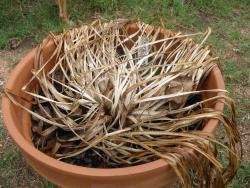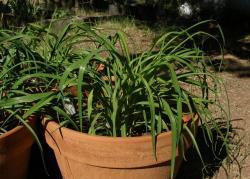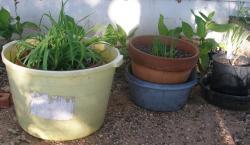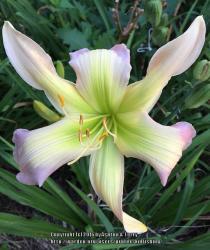




CaliFlowers said:It looks like the potting soil dried out inside and the plant collapsed in the heat. A few years ago I had a sprinkler system go bad on me right in the middle of summer during an extended absence, and had quite a few daylilies do this. I think that a lot of the fans simply "stall" and die, and that's that. I did the same thing you did and managed to save a fan here and there, but many of them were lost.
Potting soils are notorious for drying out and being difficult to re-wet. In terracotta pots, I like to mix potting soil with good garden soil 50-50 in the bottom half, (if the garden soil is heavy clay, I use less, like 80-20.) top that with an inch of potting mix and scratch it in lightly, then fill/plant with potting mix. It gives the plants a moisture reservoir, re-wets better, and the garden soil doesn't go chalk-dry overnight like potting soil can. I've also lined the top half of them with plastic, and that helps too.
Altheabyanothername said:Donald-- do you have screens over the bottom holes? I have found pill bugs and earwigs to cause problems. I find a daylily with rot has an overabundance of them. When a daylily starts with rot pull it out of the pot and look for insects. Then I use hydrogen peroxide rinses. I learned that from Becky who had to do that to her clematis that had rot. The other solution I have used is baking soda. The other items I have wondered about is cinnamon, aspirin, Listerine and comet cleanser. Those come from other plant remedies. Comet and bleach would be at the bottom of my list to try. But I would use either comet or bleach to clean the pot before using it again. I have found in my area here that pots want to be bottomed watered. It seems to me that daylilies like water on the leaves or roots, but not on the crown. Too much water from above when they want to be heat dormant causes me the most problems. Terra cotta can be a problem, too. Terra cotta actually holds in water when the pot is evenly moist. When it dries out completely, it becomes a baker. Once it has dried out, without bottom watering or watering it heavily every couple of hours it's hard to evenly redistribute the water in the Terra itself and then the soil in the pot is unevenly watered. Many blessings for successful answers. May joy be found at your home!
Polymerous said:
What really gets me about that one seedling is the heroic efforts that I went through to save it. I was sure that I DID save that last fan, which I repotted, IN THE SHADE, with a mixture of planting mix, vermiculite, and fine redwood chips (we don't have pine fines here). Yet still, it died........
I have been trying to reconstruct what things I might have done wrong. Fertilizing in the summer? A change in fertilizers? (This year I have been using Miracle-Gro's all-purpose time release fertilizer, with some alfalfa meal and also some supplemental liquid fertilizing.I don't recall what I used last year, but prior to last year it was Osmocote.)
Right now I have seeds from that hoped-for bridge plant, and I am wondering if I should just chuck them...